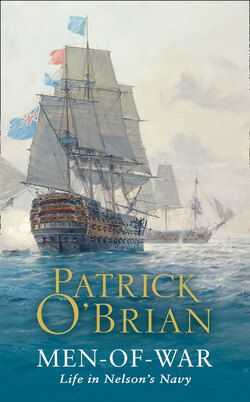Читать книгу Men-of-War - Patrick O’Brian - Страница 5
Introduction
ОглавлениеSince Britain is an island, it has always needed a navy to keep enemies from coming over the sea to invade it. If there had been an efficient navy in Roman times neither Caesar nor Claudius could have crossed the Channel; if there had been one in 1066, William would never have been called the Conqueror; and if there had not been one in the Armada year the British might be speaking Spanish now. Without the Royal Navy to stop him, Napoleon would certainly have invaded England in 1805 (he had 2,293 vessels in the Channel ports ready to carry 161,215 men and 9,059 horses across), just as Hitler would have done in 1940.
Then again, since England has been a trading nation time out of mind, it has always needed a navy to protect its merchant ships and to attack the enemy’s sea-borne trade. And ever since England became an industrial country as well, unable to produce enough food for its greatly increased population, a navy has been essential to prevent its being starved into surrender.
A navy has always been necessary; but it was not for many centuries after King Alfred’s time that the Royal Navy as we know it, a permanent service quite separate from the mercantile marine, came into being. The kings generally had some ships of their own, but in war most of the country’s naval force was made up of merchantmen, some hired and some provided by such towns as the Cinque Ports; and once the war was over they went home: they were not real men-of-war, in the sense of being ships specially built and armed for fighting alone. ‘Man’ is an odd word for a ship, since sailors call all vessels ‘she’, but ‘man-of-war’ came into the language about 1450, and it has stayed, together with East-Indiaman for a ship going to India or Guineaman for one sailing to West Africa, and many more. Henry VIII had about fifty men-of-war, and it was he who set up the Admiralty and Navy Board to look after them. Queen Elizabeth I had fewer – of the 197 English ships that sailed to fight the Spanish Armada only 34 belonged to her. Charles I had 42, but in the wars of the Commonwealth the number grew, so that when King Charles II came into his own again he had 154 vessels of all kinds. It was at this time that the Navy began to take on its modern shape: formerly the King had had to keep his ships out of his own pocket, but now the nation paid for them; and now the officers, instead of being sent away when there was no need for them, were kept on half-pay – they could make a career of the Navy rather than join from time to time. This did not apply to the men, however: they came aboard, or were brought aboard by the press-gang, every time there was a war; and when it was over they went back to their former ways of making a living. By the end of Charles II’s reign the Royal Navy had 173 vessels, and because of the labours of Samuel Pepys, the Secretary of the Admiralty, and of the Duke of York, who was Lord High Admiral, it was a fairly efficient body.
All through the eighteenth century the Royal Navy grew: in 1714 there were 247 ships amounting to 167,219 tons; in 1760 412 of 321,104 tons; and in 1793, although the number had dropped by one, the tonnage amounted to 402,555. This was at the beginning of the great war with France, in which the Royal Navy reached the height of its glory, and the numbers increased rapidly; by the time Napoleon had been dealt with, Britain had no less than 776 vessels, counting all she had taken from the French, Spaniards, Danes and Dutch; and altogether they came to 724,810 tons. At this time, at its greatest expansion, the Royal Navy needed 113,000 seamen and 31,400 Royal Marines, and a hard task it was to find them, as we shall see when we come to the press-gang.
